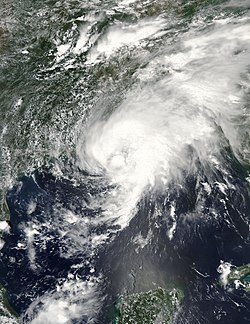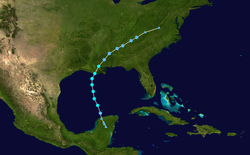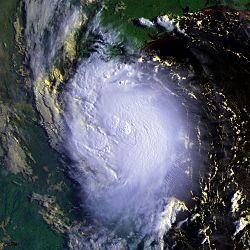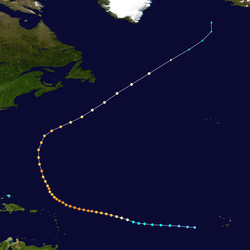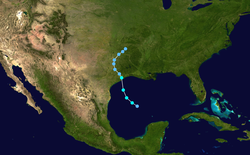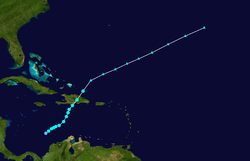The 2003 Atlantic hurricane season began on June 1, 2003 and ended November 30, 2003. However, Tropical Storm Ana formed on April 20, long before the official start of the season. Also, Tropical Storm Odette formed on December 4 and Tropical Storm Peter formed on December 7, both formed after the season ended. Hurricane Isabel is the main storm to remember, it was a category 5 that caused $3.6 billion in damage and 51 deaths in the U.S.. Another storm to remember was Hurricane Fabian, which one of the worst hurricanes in Bermuda history. The final notable storm was Hurricane Juan, a rare hurricane that caused some destruction in Nova Scotia.
2003 Atlantic hurricane season

|
| Season summary map
|
| First storm formed
|
April 20, 2003
|
|---|
| Last storm dissipated
|
December 11, 2003
|
|---|
| Strongest storm
|
Isabel – 915 mbar (hPa) (27.03 inHg), 165 mph (270 km/h)
|
|---|
| Total depressions
|
21
|
|---|
| Total storms
|
16
|
|---|
| Hurricanes
|
7
|
|---|
| Major hurricanes (Cat. 3+)
|
3
|
|---|
| Total fatalities
|
92 total
|
|---|
| Total damage
|
$4.4 billion (2003 USD)
|
|---|
Atlantic hurricane seasons
2001, 2002, 2003, 2004, 2005
|
StormsTropical Storm Ana
| Tropical storm (SSHS)
|
|---|
|
|
| Duration
|
April 20 – April 24
|
|---|
| Intensity
|
60 mph (95 km/h) (1-min), 994 mbar (hPa)
|
|---|
Tropical Storm Ana was the only one of two storms in the Atlantic Ocean that began in the month of April, the other was a subtropical storm in 1992. Ana started as Subtropical Storm Ana on April 20, it later became Tropical Storm Ana. Ana died down on April 24, but the remains reached the United Kingdom before completely dying. Ana killed two people but caused no damage.[1]
Tropical Depression Two
| Tropical depression (SSHS)
|
|---|
|
|
| Duration
|
June 11 – June 11
|
|---|
| Intensity
|
35 mph (55 km/h) (1-min), 1008 mbar (hPa)
|
|---|
Tropical Depression Two formed and dieon the same day. Tropical Depression Two did not affect land. So Tropical Depression Two did not kill anyone or cause damage.[2]
Tropical Storm Bill
| Tropical storm (SSHS)
|
|---|
|
|
| Duration
|
June 29 – July 2
|
|---|
| Intensity
|
60 mph (95 km/h) (1-min), 997 mbar (hPa)
|
|---|
Tropical Storm Bill started as Tropical Depression Two on June 29. It later became Tropical Storm Bill and made landfall in Louisiana on June 30. Bill left $50.5 million in damage and killed 4 people before dissipating on July 2.[3]
Hurricane Claudette
| Category 1 hurricane (SSHS)
|
|---|
|
|
| Duration
|
July 8 – July 17
|
|---|
| Intensity
|
90 mph (150 km/h) (1-min), 979 mbar (hPa)
|
|---|
Claudette started as Tropical Storm Claudette which that started on July 8 in the Caribbean Sea. Claudette moved west and curved northwest before getting closer to Honduras. For just a little bit Claudette was a hurricane and weakened back to a tropical storm. It later crossed the Yucatán Peninsula and became a hurricane again, before striking the coast of Texas on July 15. Claudette did not die down until July 17. The hurricane killed 3 people and left $181 million in damage.[4]
Hurricane Danny
| Category 1 hurricane (SSHS)
|
|---|
|
|
| Duration
|
July 16 – July 21
|
|---|
| Intensity
|
75 mph (120 km/h) (1-min), 1000 mbar (hPa)
|
|---|
Danny started as Tropical Depression Five on July 16. It was far from the area in which storm normally form, but water temperatures were warm and Five became a tropical storm. It even became a hurricane. But that didn't last long, Danny started weakening and became extratropical on July 21. What was left of Danny did not die down until July 27. Danny came no were near land. So, Danny killed no one and caused no damage.[5]
Tropical Depression Six
| Tropical depression (SSHS)
|
|---|
|
|
| Duration
|
July 19 – July 21
|
|---|
| Intensity
|
35 mph (55 km/h) (1-min), 1010 mbar (hPa)
|
|---|
Tropical Depression Six started on July 19. The National Hurricane Center was thinking it would become a hurricane. Six died down on July 21 without even becoming a tropical storm.[6]
Tropical Depression Seven
| Tropical depression (SSHS)
|
|---|
|
|
| Duration
|
July 25 – July 27
|
|---|
| Intensity
|
35 mph (55 km/h) (1-min), 1016 mbar (hPa)
|
|---|
Seven started on July 25 offshore Florida. Seven did not become a tropical storm before making landfall in St. Catherines Island, Georgia. Seven died down on July 27 and did not killed anyone, damage was next to nothing. Seven had the highest pressure of the storms in 2003, this made it the weakest storm in 2003.[7]
Hurricane Erika
| Category 1 hurricane (SSHS)
|
|---|
|
|
| Duration
|
August 14 – August 17
|
|---|
| Intensity
|
75 mph (120 km/h) (1-min), 986 mbar (hPa)
|
|---|
Erika started as a tropical storm just west of Florida. Erika crossed most of the Gulf of Mexico without becoming a hurricane. Erika became a hurricane right before landfall in Mexico. Erika died down on August 17, causing only $10,000 in damage and killed 2 people.[8]
Tropical Depression Nine
| Tropical depression (SSHS)
|
|---|
|
|
| Duration
|
August 21 – August 22
|
|---|
| Intensity
|
35 mph (55 km/h) (1-min), 1007 mbar (hPa)
|
|---|
Tropical Depression Nine started on August 21. People at the National Hurricane Center said that it might become a tropical storm. Wind Shear attack Tropical Depression Nine. Tropical Depression Nine died down without becoming a tropical storm. The remains caused heavy rain in Dominican Republic leaving $20,000 in damage. Nine did not actually kill anyone.[9]
Hurricane Fabian
| Category 4 hurricane (SSHS)
|
|---|
|
|
| Duration
|
August 27 – September 8
|
|---|
| Intensity
|
145 mph (230 km/h) (1-min), 939 mbar (hPa)
|
|---|
Hurricane Fabian was a powerful Cape Verde-type hurricane that hit Bermuda in early September during the 2003 Atlantic hurricane season. Fabian, the sixth named storm, fourth hurricane, and first major hurricane of the season, caused $200 million in damage and 8 deaths.
Tropical Storm Grace
| Tropical storm (SSHS)
|
|---|
|
|
| Duration
|
August 30 – September 2
|
|---|
| Intensity
|
40 mph (65 km/h) (1-min), 1007 mbar (hPa)
|
|---|
Grace was a weak tropical storm that started on August 30. It later on made landfall in Texas as a weak tropical storm. Grace died down on September 2, leaving no one killed and only $113,000 in damage.[10]
Tropical Storm Henri
| Tropical storm (SSHS)
|
|---|
|
|
| Duration
|
September 3 – September 8
|
|---|
| Intensity
|
60 mph (95 km/h) (1-min), 997 mbar (hPa)
|
|---|
Henri was a strong tropical storm that formed near Florida. Before Henri made landfall in Florida on September 6, it weakened back to a tropical depression. It crossed Florida and never became a tropical storm again. Henri died down on September 8. Henri left $19.6 million in damage and killed no one. The remains of Henri caused flooding to the some of the Mid-Atlantic states.[11]
Hurricane Isabel
| Category 5 hurricane (SSHS)
|
|---|
|
|
| Duration
|
September 6 – September 19
|
|---|
| Intensity
|
165 mph (270 km/h) (1-min), 915 mbar (hPa)
|
|---|
Hurricane Isabel was the costliest, deadliest, and strongest hurricane in the 2003 Atlantic hurricane season. It was the ninth named storm, fifth hurricane, and second major hurricane of the season. In all the storm left $3.6 billion in damage and 16 direct and 35 indirect deaths.
Tropical Depression Fourteen
| Tropical depression (SSHS)
|
|---|
|
|
| Duration
|
September 8 – September 10
|
|---|
| Intensity
|
35 mph (55 km/h) (1-min), 1007 mbar (hPa)
|
|---|
Tropical Depression Fourteen started on September 8 and died down on September 10. It only came near Cape Verde Islands. It left no one dead and did not cause any damage.[12]
Hurricane Juan
| Category 2 hurricane (SSHS)
|
|---|
|
|
| Duration
|
September 24 – September 29
|
|---|
| Intensity
|
105 mph (165 km/h) (1-min), 969 mbar (hPa)
|
|---|
Hurricane Juan started on September 24 as Tropical Depression Fifteen. The next day Fifteen became a tropical storm. It became a hurricane later and made landfall near Halifax, Nova Scotia on September 29. Juan died down on the same day while it was in the Gulf of Saint Lawrence. Hurricane Juan was one of the costliest hurricanes to strike the Canadian Providence of Nova Scotia. Hurricane Juan left 8 killed and about $200 million in damage.[13]
Hurricane Kate
| Category 3 hurricane (SSHS)
|
|---|
|
|
| Duration
|
September 25 – October 7
|
|---|
| Intensity
|
125 mph (205 km/h) (1-min), 952 mbar (hPa)
|
|---|
Kate started halfway between Africa and South America on September 25. The storm later became a hurricane, even later on, a major hurricane. Hurricane Kate at one point, looked as if it were going to strike Newfoundland, but it didn't. Kate became extratropical from because the waters of the Atlantic were getting colder. Kate died down on October 7, but the remains were last seen near Norway.[14]
Tropical Storm Larry
| Tropical storm (SSHS)
|
|---|
|
|
| Duration
|
October 1 – October 6
|
|---|
| Intensity
|
65 mph (100 km/h) (1-min), 993 mbar (hPa)
|
|---|
Larry started on October 1 in the southern Gulf of Mexico. The storm moved slowly south into the Bay of Campeche. Larry made landfall in Tabasco, which is a state in Mexico on October 5. Tropical Storm Larry died down the next day and moved into the Pacific Ocean without reforming. Larry caused $53.4 million in damage and it killed 5 people.[15]
Tropical Storm Mindy
| Tropical storm (SSHS)
|
|---|
|
|
| Duration
|
October 10 – October 14
|
|---|
| Intensity
|
45 mph (75 km/h) (1-min), 1002 mbar (hPa)
|
|---|
Mindy was a weak tropical storm that started on October 10, just north of Dominican Republic. The storm moved northwest towards the Bahamas. Mindy curved to the north and later on to the east before getting close to the Bahamas. Tropical Storm Mindy died down on October 14 after killing no one and causing only $46,000 in damage.[16]
Tropical Storm Nicholas
| Tropical storm (SSHS)
|
|---|
|
|
| Duration
|
October 13 – October 23
|
|---|
| Intensity
|
70 mph (110 km/h) (1-min), 990 mbar (hPa)
|
|---|
Nicholas was a tropical storm that formed about halfway between Africa and South America. It moved around in the Atlantic Ocean and almost became a hurricane. Tropical Storm Nicholas died down on October 23, without becoming a hurricane. The remains of Nicholas moved across the Atlantic Ocean to Florida. The remains later on moved across the Gulf of Mexico and the Gulf Coast. What was left of it was last seen on November 5.
Tropical Storm Odette
| Tropical storm (SSHS)
|
|---|
|
|
| Duration
|
December 4 – December 7
|
|---|
| Intensity
|
65 mph (100 km/h) (1-min), 993 mbar (hPa)
|
|---|
Odette was the first tropical storm in December since Hurricane Lili in 1984. On December 6 Odette made landfall in Dominican Republic and went into the Atlantic Ocean. Where it died down the next day. Tropical Storm Odette killed 10 and left $8 million in damage.[17]
Tropical Storm Peter
| Tropical storm (SSHS)
|
|---|
|
|
| Duration
|
December 7 – December 11
|
|---|
| Intensity
|
70 mph (110 km/h) (1-min), 990 mbar (hPa)
|
|---|
Tropical Storm Peter was a rare second December storm. Peter almost became a hurricane but cold waters killed it on December 11. Peter was one of eleven "P" names used in the Atlantic Ocean.[18]
Storm names
The names listed are a list of names that were used (and some not used) in 2003. The list is exactly the same as the list used in 1997, because no names were retired in 1997. The names that were not retired might be used again in the year 2009.
- Ana
- Bill
- Claudette
- Danny
- Erika
- Fabian
- Grace
|
|
- Odette
- Peter
- Rose (unused)
- Sam (unused)
- Teresa (unused)
- Victor (unused)
- Wanda (unused)
|
Retirement2003 Atlantic Hurricane SeasonTropical Storm Peter Media
Three simultaneous tropical cyclones on September 7, Henri (left), Fabian (center) and Isabel (right).
Related pagesReferencesOther websites




